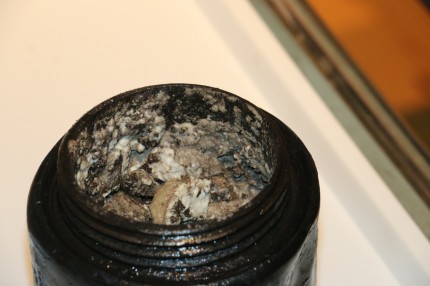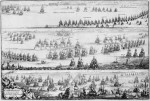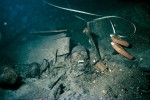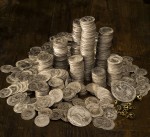 Divers have recovered a tin of very old, very stinky cheese from the wreck of the Swedish royal ship Kronan off the coast of Öland in the Baltic Sea. The ship went down in 1676, so the cheese is 340 years old. (One hopes it hadn’t been on the ship a full year or more before it went down.)
Divers have recovered a tin of very old, very stinky cheese from the wreck of the Swedish royal ship Kronan off the coast of Öland in the Baltic Sea. The ship went down in 1676, so the cheese is 340 years old. (One hopes it hadn’t been on the ship a full year or more before it went down.)
“It looks a bit like some kind of granular Roquefort cheese. It’s been in the mud, so it’s reasonably well preserved, but at the same time it has been at the bottom of the sea for 340 years – we’re not talking Tutankhamun’s burial chamber,” [Lars Einarsson of the Kalmar County Museum] said.
Einarsson said the thick, gooey find smells strongly of cheese and yeast.
“I think it smells quite nice, because I like exotic food. But I would not want to taste it.”
I wonder why. What, you can’t handle 340-years worth of bacterial growth in unpasteurized cheese, Mr. Einarsson? Somebody get Andrew Zimmern over there.

The cheese is being kept cool at the Kalmar County Museum for now. It will be subjected to a battery of scientific test to identify it first as cheese (it’s almost certainly a dairy product, but it could have gone bad and been contaminated by God knows what to make it clumpy and smell like cheese), and then perhaps what type it is.
 The royal ship Kronan was built by shipwright Francis Sheldon who had fled England after participating in a failed attempt to free King Charles I from prison. He was received in Sweden most warmly by King Charles X Gustavus who promptly put him to work building ships for his navy. In 1655, the Swedish admiralty hired Sheldon as master shipwright of the navy. He was in the right place at the right time. In the 1660s Sweden began a program of replacing its aging fleet with new warships, larger, more heavily armoured and armed, capable of withstanding the popular tactic of brutal broadside attacks that had replaced the old-fashioned style of short-range artillery exchanges culminating in boarding the wounded but functional enemy vessel.
The royal ship Kronan was built by shipwright Francis Sheldon who had fled England after participating in a failed attempt to free King Charles I from prison. He was received in Sweden most warmly by King Charles X Gustavus who promptly put him to work building ships for his navy. In 1655, the Swedish admiralty hired Sheldon as master shipwright of the navy. He was in the right place at the right time. In the 1660s Sweden began a program of replacing its aging fleet with new warships, larger, more heavily armoured and armed, capable of withstanding the popular tactic of brutal broadside attacks that had replaced the old-fashioned style of short-range artillery exchanges culminating in boarding the wounded but functional enemy vessel.
 Construction on the Kronan began on October 27th, 1665, when the keel was laid in Stockholm’s royal shipyard. It was meant to replace the previous flagship and bearer of the name which was by then 33 years old. Made entirely out of oak (about 20 acres of a 100-year-old oak forest was cut down to make the ship), the Kronan was 197 feet long and 42 feet wide, the third or fourth largest ship in the world at that time. It took another three years before the hull was laid. The admiralty and Sheldon fought the whole time, them accusing him of delaying construction by working on private projects, including a lucrative side business selling some of that oak to England; he accused them of holding back promised funds making it impossible for him and his crew to do the job.
Construction on the Kronan began on October 27th, 1665, when the keel was laid in Stockholm’s royal shipyard. It was meant to replace the previous flagship and bearer of the name which was by then 33 years old. Made entirely out of oak (about 20 acres of a 100-year-old oak forest was cut down to make the ship), the Kronan was 197 feet long and 42 feet wide, the third or fourth largest ship in the world at that time. It took another three years before the hull was laid. The admiralty and Sheldon fought the whole time, them accusing him of delaying construction by working on private projects, including a lucrative side business selling some of that oak to England; he accused them of holding back promised funds making it impossible for him and his crew to do the job.
 Finally in 1672 the Kronan was finished. The gaudy ship, so known because of the decorative style meant to intimidate the enemy with gloriously gilded details, sailed for the first time in December in the celebration of Charles XI’s coronation. When loaded for bear, the ship carried 126 bronze cannons on three decks. It was manned by a large crew of 500 sailors and 350 soldiers. In 1675, the new Kronan officially became the flagship of Sweden’s royal navy. It only had a year to live.
Finally in 1672 the Kronan was finished. The gaudy ship, so known because of the decorative style meant to intimidate the enemy with gloriously gilded details, sailed for the first time in December in the celebration of Charles XI’s coronation. When loaded for bear, the ship carried 126 bronze cannons on three decks. It was manned by a large crew of 500 sailors and 350 soldiers. In 1675, the new Kronan officially became the flagship of Sweden’s royal navy. It only had a year to live.
 During a storm before the beginning of an action at the Battle of Öland on June 1st, 1676, the Kronan capsized after making a sharp turn with too much sail unfurled. The gunpowder stores ignited and the bow of the ship exploded. Laden with cannon, coin, weapons and the personal items of nearly a thousand men who called it home much of the year, the Kronan sank rapidly, taking 800 souls with it. Only 50 men survived. Its fellow gaudy ship the Svärdet, whose wreck was found in 2011, sank after a fireship attack in the same battle, an immense toll on Sweden’s navy inflicted in just one encounter.
During a storm before the beginning of an action at the Battle of Öland on June 1st, 1676, the Kronan capsized after making a sharp turn with too much sail unfurled. The gunpowder stores ignited and the bow of the ship exploded. Laden with cannon, coin, weapons and the personal items of nearly a thousand men who called it home much of the year, the Kronan sank rapidly, taking 800 souls with it. Only 50 men survived. Its fellow gaudy ship the Svärdet, whose wreck was found in 2011, sank after a fireship attack in the same battle, an immense toll on Sweden’s navy inflicted in just one encounter.
 Some of the cannons were salvaged from the Kronan wreck in the 1680s, but it wasn’t until 200 years later that the wreck of the Kronan was rediscovered off the southwest coast of Öland and fully explored by maritime archaeologists. It was found by Anders Franzén, famous for having found the exceptional wreck of the Vasa in Stockholm harbour, and has been dived regularly ever since. In the 36 years since its discovery, more than 30,000 artifacts have been recovered from the wreck site, including Sweden’s largest ever find of gold coins — 255 ducats minted in Sweden, central Europe, Egypt, Syria and Turkey — and Sweden’s largest ever find of silver coins.
Some of the cannons were salvaged from the Kronan wreck in the 1680s, but it wasn’t until 200 years later that the wreck of the Kronan was rediscovered off the southwest coast of Öland and fully explored by maritime archaeologists. It was found by Anders Franzén, famous for having found the exceptional wreck of the Vasa in Stockholm harbour, and has been dived regularly ever since. In the 36 years since its discovery, more than 30,000 artifacts have been recovered from the wreck site, including Sweden’s largest ever find of gold coins — 255 ducats minted in Sweden, central Europe, Egypt, Syria and Turkey — and Sweden’s largest ever find of silver coins.
 The dives this month that discovered the cheese also found another 14 gold coins, the most that have been recovered the Kronan in 16 years, a large number of pharmaceuticals, many of them for gastrointestinal illnesses (cheese, we’re looking in your direction), and a very rare gold and diamond ring. A jeweler in Kalmar who examined the ring said it was the oldest diamond ring he’d ever seen.
The dives this month that discovered the cheese also found another 14 gold coins, the most that have been recovered the Kronan in 16 years, a large number of pharmaceuticals, many of them for gastrointestinal illnesses (cheese, we’re looking in your direction), and a very rare gold and diamond ring. A jeweler in Kalmar who examined the ring said it was the oldest diamond ring he’d ever seen.
The wreck is about 90% mapped now. Lars Einarsson estimates it will take another three years of summer dives to complete the survey, which means the Kronan will have provided archaeologists with fascinating new material every year for 40 years. The Kalmar County Museum has a permanent exhibition dedicated to the Kronan with many of the artifacts recovered from wreck on display. Visitors can even load one of the cannons.
I was wondering what that smell was…. (snicker)
Great pics, particularly the one with the equally preserved skull – For VERY good reason, “Surströmming” (fish from Sweden) is BANNED from being transported in airplanes. :skull:
Cheese that one should NOT eat, it is unpasteurized one, as bacterial growth is key for good quality cheese making in the first place. However, to really take eating 340 years old cheese into consideration, you probably need to be Swedish.
Also, that “cheese” is a rather small one, particularly for a “Royal Ship”. The container is also rather strange. It would make sense, however, if the stuff had been of the more cream-cheesy kind of matter.
I assume that large surface ships are obsolete in modern navies. If a serious war breaks out, they’ll go the bottom in large numbers. Those with nuclear power are unlikely to be “dived” for some time.
Absolutely fascinating! I can not help to mention that one of my direct ancestors was a Dutch captain who fought at the battle of Oland. He must have seen the Kronan going down. Somehow this news and these picture make me feel must closer to him. :thanks: